|
Displaying items by tag: Museum of Fine Arts
Following lengthy rounds of quiet negotiations, the Museum of Fine Arts has signed a memorandum of understanding with Tufts University to transfer the School of the Museum of Fine Arts to Tufts.
The agreement, which has been initially approved by both institutions’ boards, would become effective June 30, paving the way for the art school’s more than 700 students and roughly 145 faculty members to come under the Tufts banner.
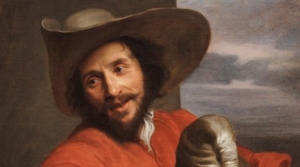
British businessman and art collector James Stunt has loaned Boston’s Museum of Fine Arts (MFA) five portraits by European masters Anthony van Dyck, Peter Lely, Joshua Reynolds, Thomas Lawrence, and John Constable. Van Dyck’s portrait of Francois Langlois, a French art dealer, publisher, and amateur musician, as an itinerant performer is on view in the museum’s Leo and Phyllis Beranek Gallery. Lely’s portrait of the notorious entertainer and socialite Moll Davis is on view in the MFA’s Hamilton Palace Room. The works by Reynolds, Lawrence, and Constable will be installed next week.
Stunt, who has homes in Los Angeles and London, is an avid collector of British portraiture. He recently offered to buy van Dyck’s last self portrait, which he planned to loan to the MFA, but an outpouring of public support to keep the painting in England caused Stunt to withdraw his offer. there is currently an ongoing public fundraising appeal to purchase the painting so that it will remain on view in the U.K.
Malcolm Rogers, the MFA’s Ann and Graham Gund Director, said, “We’re extremely grateful to Mr. Stunt for sharing these important portraits with the MFA. The works complement the MFA’s collection of European portraiture, giving our visitors added insight into art of the period and providing an opportunity to see artists that are not found in great depth in New England collections.”
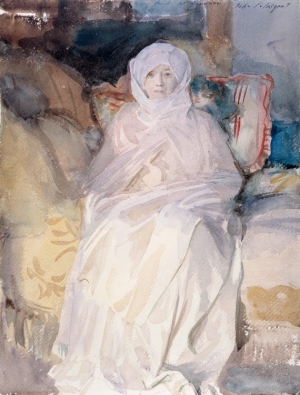
The Isabella Stewart Gardner Museum in Boston presents the exhibition The Inscrutable Eye: Watercolors by John Singer Sargent, which includes eight paintings that explore the artist’s relationship with the museum’s founder, Isabella Stewart Gardner. The show runs concurrent to the Museum of Fine Arts, Boston’s exhibition John Singer Sargent Watercolors.
Sargent and Gardner shared a long-lasting friendship after meeting at the artist’s studio in London in 1886 by arrangement of their mutual friend, the writer Henry James. Besides the watercolors, the exhibition includes personal mementos such as letters and photographs that span their lifelong friendship.
The Gardner Museum is home to numerous works by Sargent as Gardner acquired 42 of his paintings during their acquaintance. The institution’s holdings span every stage of Sargent’s career and include genre paintings, formal oil paintings, watercolors, studies for public murals and personal sketches. Gardner acquired many of the watercolor paintings on display through buying gifts Sargent made for his friends as they came onto the public market.
The Inscrutable Eye: Watercolors by John Singer Sargent will be on view at the Isabella Stewart Gardner Museum through January 20, 2014.
The Museum of Fine Arts in Boston presents the exhibition Audubon’s Birds, Audubon’s Words. The show features approximately 30 prints from the museum’s copy of John James Audubon’s seminal work The Birds of America alongside the prose he originally wrote for the book.
The naturalist and painter is best known for his life-size, hand-colored prints illustrating the wide variety of birds in North America. The MFA’s exhibition aims to bring attention to Audubon’s undervalued text, which he original wrote to describe each bird he portrayed in Birds of America. However, the first edition of the book was printed between 1827 and 1838 without words. The MFA’s presentation of Audubon’s prose allows patrons the chance to read first-hand accounts of the methods the artist used to depict the birds and the trials associated with his substantial project.
Audubon’s Birds, Audubon’s Words will be on view at the MFA through May 11, 2014.
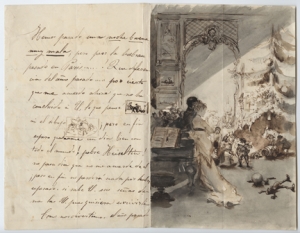
The Meadows Museum at the Southern Methodist University in Dallas has acquired an album of drawings, photographs and letters amassed by the sugar tycoon and art collector William Hood Stewart. Stewart was an avid collector of European art and the Modern Spanish School and his holdings include correspondence with artists such as Jean-August-Dominique Ingres (1780-1867) and Jéan-Léon Gerôme as well as with fellow collectors. The Meadows Museum acquired the album from New York’s Spanierman Gallery for an undisclosed amount.
The collection will be presented at the Meadows Museum in the exhibition The Stewart Album: Art, Letters and Souvenirs to an American Patron in Paris from August 25 through November 10, 2013. While Stewart had a sizable estate in his hometown of Philadelphia, he spent much of time in Paris, socializing with the artists he so admired. Stewart’s unique collection provides a glimpse into the careers, personal lives and artistic developments of a number of important European artists.
In 1898, Seven years after Stewart’s death, his collection was broken up at an auction and paintings were dispersed among the Metropolitan Museum of Art, the Walters Art Museum in Baltimore, the Museum of Fine Arts in Boston and a handful of other institutions. The Meadows Museum is planning to organize an exhibition that will reunite parts of Stewart’s collection that were separated over 100 years ago.
For the first time in its long history, the Museum of Fine Arts, Boston, has a gallery dedicated to the display and interpretation of the magnificent arts of Native Americans. The new gallery presents a broad overview of the diverse works of art created by Native Americans across the continent from ancient times to the present day. Many rarely seen textiles and other light-sensitive objects will be displayed for the first time, with additional examples going on view in rotation in the future. Centrally located in the new Art of the Americas Wing, the Native American Gallery is situated next to galleries devoted to the arts of ancient Central and South America, presenting a long sweep of the arts of the indigenous peoples of the Americas.
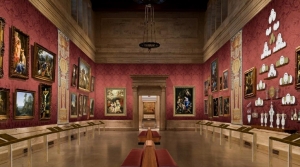
There was a time when Anthony Van Dyck’s Isabella, Lady de La Warr was considered one of the most important paintings at Boston’s Museum of Fine Arts. Purchased in 1930 for $121,440 by the MFA donor, Mrs. Frederick T. Bradbury, the work went on view in the Hamilton Palace period room. It wasn’t until the 1980s when the painting went into storage that Isabella’s future started to look bleak.
When Malcolm Rogers rediscovered Isabella not long after he took over as the MFA’s director in 1994, he found the painting’s surface was discolored from protective varnishes and shoddy retouching had left the work with mismatched paint. Painted by the Flemish artist in 1638 during a stay in England, Rogers knew that Isabella could be recovered. A technical examination in 2011 reinforced Rogers’ belief.
The painting underwent nearly a year of restoration by the MFA’s paintings conservator, Rhona MacBeth and has just been installed in the MFA’s newly renovated Koch Gallery. Depicting an elegant woman, the wife of Lord Henry who served as a diplomat and treasurer of one of Van Dyck’s most famous subjects, England’s King Charles I, the painting is an excellent example of aristocratic portraiture that was in high demand by American collectors during the first few decades of the 20th century.
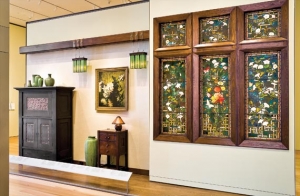
The Lorraine and Alan Bressler Gallery in the new Art of the Americas Wing at the Museum of Fine Arts, Boston, features works inspired by the American Arts and Crafts movement (Fig. 1). Despite the fact that the founding and early formative years of the museum were integrally related to the development of the Arts and Crafts movement in Boston and the United States at large, this is the first time in the MFA’s 140-year history that a significant gallery has been dedicated to this material.
The MFA’s founding in 1870 was in part motivated by design reform efforts begun earlier in the century in England. Design reformers lamented the decline in aesthetic standards brought on by industrial production, and debated the role of art, design, and morality in ornament and manufacture and, by extension, in everyday life. With “Art, Industry, Education” as its motto, the MFA was modeled after London’s South Kensington Museum (now the Victoria and Albert Museum, established in 1852), as a “resource whence artisanship and handicraft of all sorts may better and beautify our dwellings, our ornaments, our garments, our implements of daily life.” 1 The art and artifacts (or copies of originals) shown in the MFA were meant to inspire and educate artists, designers, and the general public, and therefore improve the aesthetic quality of manufactures and domestic settings in Boston and beyond.
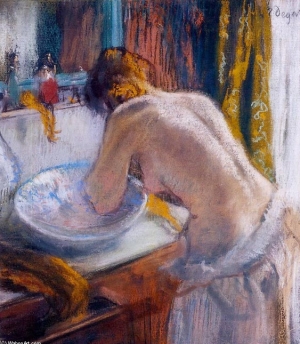
The first museum exhibition devoted exclusively to the extraordinary range of nudes by Edgar Degas—tracing their evolution from the artist’s early years, through the private and public images of brothels and bathers in the 1870s and 1880s, to the post-Impressionist nudes of the end of his career—will be presented by the Museum of Fine Arts, Boston (MFA), and the Musée d’Orsay, Paris. Degas and the Nude, on view October 9, 2011, through February 5, 2012, at the MFA, will offer a groundbreaking examination of Degas’s concept of the human body during the course of 50 years by showing his work within the broader context of his forebears, contemporaries, and followers in 19th-century France, among them Ingres, Delacroix, Cassatt, Caillebotte, Renoir, Toulouse-Lautrec, Matisse, and Picasso. Assembled from the collections of more than 50 lenders from around the world are approximately 165 works—145 by Degas—including paintings, pastels, drawings, monotypes, etchings, lithographs, and sculptures, many of which have never been on view in the United States. After its debut in the MFA’s Ann and Graham Gund Gallery—its only US venue—Degas and the Nude will be shown at the Musée d’Orsay from March 12–July 1, 2012. Presentation of the exhibition in Boston is made possible by Bank of America. This exhibition is supported by an indemnity from the Federal Council on the Arts and the Humanities.
The 19th-century French artist Edgar Degas (1834–1917), a founding member of the Impressionist group who gravitated toward realism, is acclaimed for his mastery of a wide range of genres, which he executed in all media using a variety of techniques. In addition to his famous depictions of ballet dancers or racing subjects, Degas’s work also included history paintings, portraits, landscapes, and scenes of urban leisure. This exhibition, however, will focus entirely on his nudes, illustrating the transformation of Degas’s treatment of the human form throughout half a century—from early life drawings in the 1850s, to overtly sexual imagery, to gritty realist nudes, and beyond to the lyrical and dynamic bodies of the last decade of his working life when the theme dominated his artistic production in all media.
“Degas and the Nude will be a revelation for our visitors. It will offer a number of surprises—for instance, we’ll reunite several of Degas’s black-and-white monotypes with the corresponding pastel ‘twins’ for the first time since they left the artist’s studio,” said Malcolm Rogers, Ann and Graham Gund Director of the MFA. “Visitors will see the progression of his nudes and the very heart of Degas’s fascination with the body and its range of emotion and movement. He pursued that fascination in portraits, and above all in images of dancers, but in the nude we see the body in its purest form…through Degas’s eye and imagination.”
Degas and the Nude draws from some of the finest collections in the world. In addition to the MFA and Musée d’Orsay—the single largest lender, with more than 60 works—these include the National Gallery and Courtauld Gallery, London; the Musée Andre Malraux, Le Havre; museums and private collections in Germany, Japan, and Switzerland; as well as the Metropolitan Museum of Art, the Art Institute of Chicago, and the Philadelphia Museum of Art, among many other museums and private collections in North America. The exhibition will feature such masterpieces as Young Spartans Exercising (1860-62, National Gallery, London) and Scene of War in the Middle Ages (1863–65, Musée d’Orsay, Paris), two of Degas’s greatest history paintings; and The Tub (about 1886, Musée d’Orsay), a pastel completed at the height of his career and presented at the last Impressionist exhibition in 1886. It will also offer context to this exploration of the artist’s nudes by juxtaposing his works with those created by major artists who influenced—or were influenced by—Degas, including Ingres’s Angelica Saved by Ruggiero (1819-39, National Gallery, London), Caillebotte’s Man at his Bath (1884, Private Collection), and Picasso’s Nude on a Red Background (1906, Musée de l'Orangerie, Paris).
More than three years in the making, Degas and the Nude was conceived by George T.M. Shackelford, Chair, Art of Europe and Arthur K. Solomon Curator of Modern Art at the MFA, who co-organized the exhibition with Xavier Rey, Curator of Paintings, Musée d'Orsay. “Our project explores how Degas exploited all of the body’s expressive possibilities,” Shackelford said. “It shows how his personal vision of the nude informed his notion of modernity, and how he abandoned the classical or historical form in favor of a figure seen in her own time and setting, whether engaged in shockingly carnal acts or just stepping out of an ordinary bath.”
“The first works by Degas to enter the collections of the French State were pastels of nudes bequeathed to the nation by Gustave Caillebotte in 1894,” said Xavier Rey, exhibition co-curator. “In the ensuing century, the Musée d’Orsay has become The Tub, 1886, Edgar Degas the world’s greatest repository of Degas’s depictions of the nude—in paintings, pastels, drawings, and sculpture. We take pride in co-organizing this major international project, which will be one of the important exhibitions in Paris in 2012.”
Degas and the Nude is organized into six sections, which will explore:
- Degas’s earliest nudes, from about 1855 to 1862
- The artist’s early masterwork, Scene of War in the Middle Ages, and the studies that preceded it
- Brothel monotypes Degas executed in the latter half of the 1870s
- Transformation of Degas’s brothel imagery to scenes of daily life
- Select works from the artist’s key years of 1884–86
- Degas’s last years as an artist, from about 1890 to 1905
The exhibition will begin with a selection of the artist’s first nudes, including Study of Michelangelo’s Bound Slave (1855–60, Private Collection), one of Degas’s many studies of works by Renaissance artists that he made in Paris or in Italy, where he drew from live models at Rome’s French Academy. Many life studies and paintings created as part of this early academic training will be on display, as well as drawings made for early figural compositions, culminating in the painting Young Spartans Exercising (1860–62, National Gallery, London), a depiction of girls beckoning or taunting a group of boys, with the landscape of ancient Sparta as a background.
One of Degas’s most notable works incorporating nudes, the history painting Scene of War in the Middle Ages, will be the focal point of the second section of the exhibition. The often overlooked masterpiece was the first work Degas exhibited at the official Salon in 1865. It will offer an early view of some of the many poses the artist would repeat throughout his career. Complementing it will be more than a dozen of the studies that preceded it, as well as works by other artists who exerted an influence on Degas in the conception and elaboration of the painting, such as Jean Auguste Dominique Ingres (1780–1867), whose Angelica Saved by Ruggiero will be displayed along with a masterwork by Eugène Delacroix (1798–1863): The Death of Sardanapalus (1844, Philadelphia Museum of Art). These two French masters, as well as artists such as Francisco de Goya y Lucientes (1746–1828) and Pierre Puvis de Chavannes (1824–1898), provided inspiration for the young Degas. Two paintings by Degas from the later 1860s also will be shown: Interior (The Rape) (1868–69, Philadelphia Museum of Art) and Peasant Girls Bathing in the Sea at Dusk (about 1869, revised later, Private Collection).
The exhibition’s third section will be devoted to the brothel monotypes that Degas executed in the latter half of the 1870s— images that are at times caricature-like, ironic, pornographic, or even unexpectedly tender. These often sexually explicit scenes depict women in brothels: waiting for clients, as in The Reluctant Client (1876-77, National Gallery of Canada), and engaging in sexual acts, as in Two Women (1876–77, MFA). Most of these works are relatively small in scale, made as drawings using brush and greasy ink on metal plates, which were then printed to yield one proof (“mono-type”); sometimes a second, fainter, impression was taken. The monotypes were occasionally touched with pastel; some—more often the second impressions—were completely covered with color to become small pictures, ready for sale or gift.
The evolution of Degas’s nudes will continue in a following section, shifting from overtly sexual imagery to the everyday, “naturalist” nudes, as seen in the artist’s spontaneous views of ordinary, seemingly unposed women at various stages of undress or performing “la toilette”—bathing, drying, or grooming themselves. These monotypes will highlight the emergence of the bather as a central theme in Degas’s art—one that he would explore from the middle of the 1880s until the end of his career. Many of these later monotypes were made in a way that differed from the first ones, showing the artist’s interest in exploring a variety of techniques and materials. Rather than painting his image with a brush, Degas inked the entire plate and “pulled” the image out of the ink with selective wiping and scraping. In this section, some monotypes will be united with their corresponding pastels for what is believed to be the first time. These include the monotype Woman in a Bathtub (about 1850–85, Private Collection), and the pastel over monotype Woman in Her Bath, Sponging her Leg (1883–84, Musée d’Orsay). Other pastels and oil paintings will be featured here, as well as comparisons to the work of Mary Stevenson Cassatt (1844–1926), Woman Bathing (1890–91, The Metropolitan Museum of Art), and Henri de Toulouse-Lautrec (1864–1901), La Toilette (Rousse) (1889, Musée d’Orsay). The section will culminate in a group of large-scale oil paintings by Degas and his friends Gustave Caillbotte (1848–1894) and Henri Gervex (1852–1929), made between the years 1878 and about 1884.
Works from a pivotal time in Degas’s career, 1884–86, will be examined in section five of the exhibition. Two examples, The Tub (1885–86, Musée d’Orsay) and Woman Dressing Herself (1885–86, National Gallery of Art, Washington, DC) were included in the last Impressionist exhibition, held in Paris in the spring of 1886. In addition, comparative paintings by Pierre- Auguste Renoir (1841–1919), Woman Combing Her Hair (1882–83, Private Collection), and Puvis de Chavannes, Young Woman at Her Toilette (1883, Musée d’Orsay), will be displayed, as well as works from the late 1880s that expand upon those created a few years earlier. Also included will be the sculpture The Tub (Musée d’Orsay, 1889 modeled, cast 1920–21), cast in bronze after the artist’s death.
Degas and the Nude will conclude with an exploration of Degas’s last years as an artist, from about 1890 to 1905. “During this period, Degas is focused almost exclusively on the bather, with the exception of a few great drawings and sculptures depicting dancers. His color sense grows bolder, and as he nears the end of the 1890s, his painting and drawing technique become more experimental and, likewise, more bold,” explained Shackelford. “Influences of such artists as Gauguin and Rodin are felt in his painted compositions and sculpture. Sinuous lines, sensual hatchings, delicate blending and shading, and large scale mark his later charcoal drawings of bathers, among the most accomplished sheets in his career, and a radical departure from the carefully rendered nudes of 1855–1865.” Featured here will be the largest single grouping in the exhibition, which will showcase Degas’s masterpieces, After the Bath (about 1896, Philadelphia Museum of Art) and After the Bath (1895-1900, The Phillips Collection, Washington, DC). In addition, to illustrate Degas’s influence on the next generation of great artists, paintings by Degas will be juxtaposed with those by Pierre Bonnard (1867–1947), Henry Matisse (1889–1954), and Pablo Picasso (1881–1973). In the context of Degas’s great nudes of the 1890s, Bonnard’s Indolence (1899, Musée d’Orsay), Matisse’s Carmelina (1903, MFA), and Picasso’s Nude on a Red Background (1906, Musée de l'Orangerie, Paris) take on new meaning, as masterworks by the youthful standard-bearers of Degas’s post-Impressionist style in a new century.
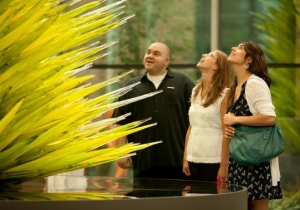
They’ve waited in line for hours, blogged their rave reviews, and begged the Museum of Fine Arts to keep the tower of green glass even after the smash success Dale Chihuly exhibition closes.
Now, visitors to the Museum of Fine Arts are being given a chance to put their money behind their pleas.
The MFA has launched a campaign to raise more than $1 million to buy the 42-foot-tall “Lime Green Icicle Tower,’’ a signature work by the glass artist that’s been grabbing attention in the museum’s new Shapiro Family Courtyard since “Chihuly: Through the Looking Glass’’ opened in April. The public contributions will be matched by those of a group of longtime MFA donors.
It is fairly standard, these days, for a museum to acquire a work from an artist who has been featured in a solo exhibition. But typically, deep-pocketed donors are sought to make those purchases. The MFA’s public appeal includes, for the first time, a chance for museum visitors to give online and by texting on their phones - people can text the word TOWER to 50555, then reply to the follow-up message “To confirm your $10 donation to MFA Boston, reply with the word YES.’’
“People indicated clearly they wanted the piece to stay,’’ said Malcolm Rogers, the MFA director. “Many ordinary people indicated they wanted to give. It’s a great opportunity for people to give in a quite modest way and feel they contributed to making this a great place.’’
The MFA quietly began the campaign last week by adding a donation box next to the piece and sending an e-mail to museum members pointing them to the contribution website. This week, they plan to add tweets and Facebook posts to spread the word.
And later in August, an e-mail blast detailing the campaign will go out to anyone who has visited the Chihuly show. In recent weekends, people have waited hours to see the artist’s works. This week, attendance surpassed 320,000, meaning that when Chihuly closes Aug. 7, it will be at least the fifth-most-visited MFA exhibit of all time, behind just “Monet in the 20th Century,’’ “Monet in the ’90s,’’ “Renoir,’’ and “Pompeii 79 A.D.,’’ which were held in 1999, 1990, 1986, and 1978, respectively.
|
|
|
|
|